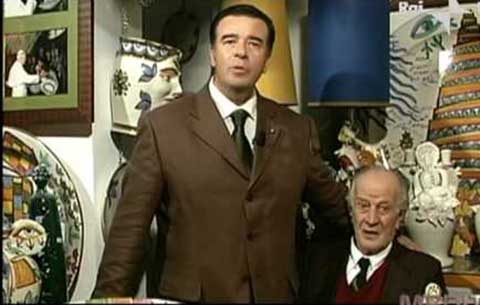In 1683 the first contact with the Duke of Camastra for a stable presence of the factory in Santo Stefano di Camastra, a town which in that period was organizing its historic reconstruction.
In the 18th century the Piscitello factory brand is present in many Sicilian noble homes and in particular a member of the family, Rosario Piscitello with his brothers, gave a great boost to the factory's industrial activity, as demonstrated by the historical finds and the discovery of numerous tiles finely crafted majolica tiles in many Sicilian churches.
In modern times, Prof. Mario Columba, dean of the engineering faculty of the University of Palermo, collector and expert in historical ceramics, with his collaborators brought to light many tiles from the Piscitello family in the depths of Lipari, demonstrating the fact that most of the commercial activity of that period took place throughout the Mediterranean and Tyrrhenian Sea.
The production of Piscitello over the various years has diversified based on market demand which, with the changing economy, required product diversification.
Due to its originality in design and composition, the Piscitello majolica tile was not only appreciated in Sicily (in the most beautiful noble houses of the Sicilian aristocracy) but was placed on the market throughout the Mediterranean basin.
As the years passed with the transformation of the economic and social reality of the island, it was deemed appropriate to diversify production, adding to the historic production of tiles also that of jars, which satisfied a market of rich and large landowners, the whose oil production was at that time an important item in the economic chapter for Sicily.
It's in the 20th century. that the Piscitellos achieved international fame for the quality of the product which became a true art object reaching international markets.

Immediately after the end of the Second World War, with the return of Antonino Piscitello from imprisonment in the Nazi camps, the Premiata Fabbrica D'arte Antonino Piscitello moved to the current factory located in Via Nazionale 110, where one of the strongest production of dishes began , to satisfy the Sicilian market which made considerable demand for it.
From this moment on, Antonino Piscitello's factory became an artistic circle where the greatest Italian artists met to create new pictorial experiments on ceramics.
It is in this period that a collaboration began between Antonino Piscitello and the greatest artists such as Bianchi and Rosati of the Brera school (MI); of the school of Faenza the great prof. Biangini; of the Palermo school, prof. De Lisi and finally the collaboration that lasted for years with prof. Boncompagni, known when Antonino Piscitello attended the Art Institute.
Precisely from this great and creative collaboration of such illustrious artists, the lines, colors and designs that characterize the art of the Piscitellos are created. With Antonino Piscitello, the ceramics of S. Stefano di Camastra impose their international importance, for their ability to present themselves at all the market exhibitions of the most important capitals of the world and always receiving commendable recognition from art critics.
The valuable production of Antonino Piscitello, so appreciated for its technical and artistic abilities, has received notable affirmations along the happy stages constituted by the international market exhibitions of Padua, Messina, Florence, the international fairs of Milan, Bari, Palermo and Reggio Calabria. It also enjoyed success in Munich, at the Chicago fair, New York, London, Tunis and at the Italian Week in Essen.
Among the various recognitions, one of the most important successes that Sicily has had in the artisanal artistic field is the brilliant affirmation and flattering success that Antonino Piscitello di S. Stefano di Camastra obtained at the 33rd "International Crafts Exhibition", held in Florence in 1969, awarded a gold medal in an international competition, where 3,600 exhibitors took part, including schools, art institutes and artisan workshops.
Antonino Piscitello, considered the first ceramist of S. Stefano di Camastra, was awarded the gold medal and the diploma of honor from the Ministry of Industry, Commerce and Crafts. This was the first gold medal awarded to artisans from S. Stefano di Camastra and it constituted not only an achievement, but above all the worthy recognition attributed to the art of artisan ceramics from Stefano which, through Antonino Piscitello, managed to establish itself in the field international, giving a boost of fame and economy to the entire country.

En 2006, la prestigieuse reconnaissance du Département du patrimoine culturel et environnemental de la région de Sicile (Commission REI - UNESCO) avec laquelle Antonino Piscitello a été déclaré « Trésor humain vivant » en l'inscrivant au Registre du patrimoine immatériel.
En 2008, la Fabbrica Ceramiche d'Arte Antonino Piscitello a reçu une mention honorable au prix UNION CAMERE, le concours d'entreprise de longue durée et réussie.
Il participe à nouveau à la 34e édition de la Fiera del Levante, obtenant la médaille d'argent (1971). La même année, il participe au 32ème salon international de Messine, obtenant à nouveau une médaille d'or. Les céramiques d'art d'Antonino Piscitello ont été considérées par diverses revues nationales et internationales comme un exemple significatif de l'art céramique sicilien.
Pour ne citer que quelques exemples, rappelons les différents articles parus dans la revue « Amica », dans la « Gazzetta del Sud » ; il a également été choisi par les éditions Zanichelli comme artiste sicilien pour leur livre d'histoire de l'art.
Et encore en 2003 lors de la 49ème édition du prix de peinture de la ville de Pizzo (VV); exposition personnelle à la galerie Il Canovaccio, atelier Canova (Rome) du 15/11 au 24/12/03 ; Musée Expression Paris 22/25 janvier 2004 ; notre personnel à la base militaire américaine d'Agnano (NA) du 07/2003 au 12/2003. |